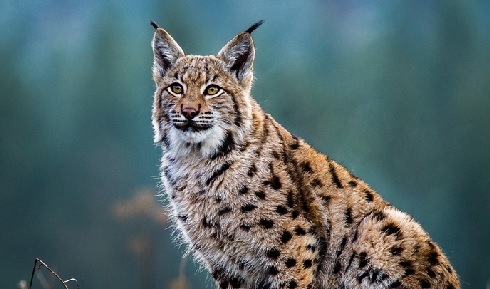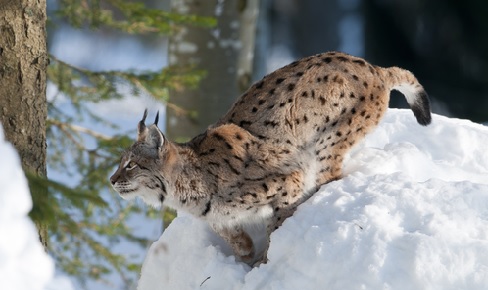The lynx effect

The Lynx UK Trust is submitting its second application to trial the reintroduction of this striking wild cat to a forest in central Scotland
May 31st 2021
Walking through a forest in the early light you see a flash of fur in the shadows between the trees. You stop, looking and listening intently, but can’t see or hear anything other than the birds chirping. Even a glimpse of the elusive Eurasian lynx (Lynx lynx) ending the night’s hunt is a special experience – most people will only ever know one has been near from footprints in the snow. This secretive nocturnal predator is currently found in rugged, hard-to-reach and dense forests across Eurasia, from western Scandinavia to Eastern Russia. But could this fantastic creature soon be glimpsed on wild walks in Scotland too?
Amid growing interest in rewilding landscapes and species reintroductions, the Lynx UK Trust is reapplying for a permit to conduct a five-year scientific trial to assess the consequences of reintroducing a small number of GPS-fitted lynx to the UK. It’s a contentious issue: the trust says it will bring ecological benefits and boost biodiversity and ecotourism, while landowners are concerned about predation of livestock and Scottish wildlife.
The case for cats
Britain lost its native apex predators – such as wolves, lynx and bears – hundreds of years ago, mainly due to overhunting and habitat loss. The lynx became extinct in the UK in around 700 AD, most likely hunted to extinction for its fur. Without an apex predator grazers and browsers can become sedentary and overgraze areas of ecological and economic importance. When an apex predator is reintroduced, scent marking across the landscape changes the behaviour of grazers and they instinctively move more to avoid predation. The Lynx UK Trust says the cats would help control overabundant roe and sika deer populations, decreasing the need for culling. The increased movement of grazers would also allow the growth of young tree saplings and other vegetation, increasing woodland and improving biodiversity.
The trust believes the lynx – with its distinctive ruffs of hair around the collar and black ear tufts – would also serve as an ambassador for nature restoration. A previous application to reintroduce lynx by the trust was rejected by Natural England in 2018. Michael Gove, environment secretary at the time, said that there were a number of concerns, including the resilience of the trust, a lack of funding and a reliance on volunteers[1]. Rewilding Britain also had a number of concerns with the trust’s first proposal[2].
Lynx and the law
The EU Habitats Directive Article 22 encourages member states to assess the feasibility of reintroduction to enhance biodiversity and reinstate species that have been exterminated by people. The UK Government’s 25-Year Environment Plan also states that reintroductions will be considered as part of the UK’s effort to meet global commitments to reduce the rate of biodiversity loss – with decision-making devolved to England, Scotland, Wales and Northern Ireland.
The first formalised reintroduction of a species in the UK was the Eurasian beaver, successfully reintroduced to Argyll, Tayside and Devon over the past decade (and after several failed applications). Eurasian and Iberian lynx have been successfully reintroduced since the 1970s to a number of European countries, including Germany, Austria, France, Switzerland, Croatia, Italy, the Czech Republic, Poland and Slovenia. Even though the lynx is a shy, elusive species, reintroduction sites have benefited from ecotourism and increased local revenues: a study on Harz National Park in Germany reported that over half of respondents cited lynx as the key reason for visiting.

Big cat caveats
However, reintroduced populations are often small and geographically separated. Studies suggest that these small, isolated populations may not be sufficient to create genetically stable and continuously distributed populations. Active management is therefore required to ensure genetic virility within populations and to prevent inbreeding. A new year-long study[3] by Vincent Wildlife Trust, in partnership with Scotland: The Big Picture and Trees for Life, will assess people’s views about the possible reintroduction. In 2020 a poll by YouGov[4] showed that the public are largely supportive of the idea of reintroducing charismatic creatures – but just 36% want to see the lynx specifically brought back (30% want to see bears reintroduced to the UK).
Opposition to the idea comes mainly from farmers and landowners who are concerned about the loss of livestock and damage to property. Lynx can attack anything from small rodents to large deer, game birds and sheep, and there are also concerns about the predation of vulnerable Scottish wildlife such as wildcats and capercaillie.
Research suggests that lynx only target such animals in times when deer populations are very limited[5], but farmers cite data from Norway, where authorities had to compensate farmers for the loss of tens of thousands of sheep, a fifth of which were believed to have been killed by lynx. The Lynx UK Trust says this is unlikely to happen at the specified reintroduction site in Queen Elizabeth Forest in the Scottish Highlands. Others opposed to the idea say that modern forests are now busy and well-used spaces, and introducing predators will lead to further human-animal conflicts. Many lynx are lost every year in traffic accidents and small populations are highly susceptible to unpredictable demographic events, which can lead to population declines.
There are, of course, other ways to kick-start woodland expansion and improve biodiversity that don’t involve releasing large predators into a new environment. For example, keeping thick, thorny vegetation (scrub), which has historically been cleared to ‘tidy up’ woodland, provides protection for seeds and saplings against grazing and browsing animals.
What next?
In Scotland, after a formal application has been submitted, a licence for a species release is required from NatureScot. The National Species Reintroduction Forum, chaired by NatureScot, represents a number of stakeholders and advises on species translocations and release. In England, a permit application would go through DEFRA and Natural England.
Whatever the outcome this time round it is undeniable that UK landscapes are suffering from severe biodiversity loss and radical steps need to be taken to protect natural areas and conserve wildlife. Whether those steps involve the arrival of these beautiful animals to the forests of central Scotland remains to be decided.
Georgina Fauconier MRSB is the RSB’s policy intern and a PhD student at Brunel University London, researching European smelt in the Thames
1) Letter from the Secretary of State for Environment, Food and Rural Affairs to the Lynx UK Trust, 30 November 2018.
2) Eurasian Lynx Policy Statement, Rewilding Britain, Accessed 30 April. rewildingbritain.org.uk
3) Eurasian Lynx Qualitative Study, Vincent Wildlife Trust, February 2021. www.vwt.org. uk/research-all/european lynx-qualitative-study
4) ‘Third of Brits would reintroduce wolves and lynxes to the UK, and a quarter want to bring back bears’. YouGov, 28 January 2020.
5) Jobin, A. et al. Prey spectrum, prey preference and consumption rates of Eurasian lynx in the Swiss Jura Mountains. Acta Theriol. 45(2), 243–252, 2000


